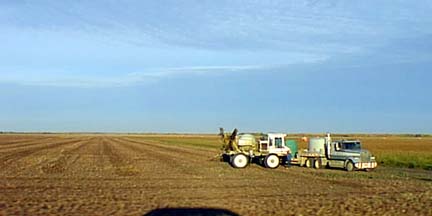Fall Work - Part 2

FTLComm - Carrot River
September 24, 1999
Earlier this week Ensign had some pictures
of fall tillage in progress and the article mention that there has been a shift to
continuous cropping and using chemicals to control weeds.
This picture was taken yesterday at about 7:45 South of Carrot River as this commercial spray machine was being loaded to apply herbicide to this harvested field pea stubble. These chemical application machines are extra ordinarily expensive (more then $100,000) and require the support of a large truck to provide the machine with a water supply and transport it from place to place. Various agricultural businesses have units like these and charge between $3.50 and $4.00 and acre to apply the chemicals. Though many farmers apply chemicals themselves with their own spray equipment, many more make use of these commercial services because the commercial applicators are fast and the farmer can avoid the costs of having money tied up in his own equipment.
Though this practice is a sign of the times several important agricultural factors are becoming apparent.
- chemical applications on a large scale are a mainstay of modern agriculture.
- farm size has reached a point where operations of this kind are economically viable.
- science and technology in agriculture is advancing at an alarming rate
Farmers have found that using these scientific developments has a produced some difficult situations. The increased productivity and farm efficiency has to be weighed against the additional input costs. As a business person, farmers now have to spend much more time calculating the advantages, or the profit margin, in the various alternatives they have to create the highest level of income from each unit of land. The complexity of these alternatives are relate to the size of the operation and the limitations of weather as it relates to manpower and time to accomplish various operations.
Though farming has evolved so much from the first half of this century the whole process is little further ahead in reducing risk. When farmers worked their fields with horses or in the next few year when they send out mini-robotic tractors into the fields, their changes in technology has done little to reduce the major obstacles to the whole process and those obstacles are still the same ones that existed when this century began and people began flooding onto the prairies. Weather and markets remain the primary issues. The present farm economic crisis relates directly to these two issues just as similar situations occurred in the years before W.W.I, in the 1930s, in the 1950s and the various crisis that smashed through the 70s.
The most remarkable problem that relates to agriculture is that we can get along without all other economic activity but there is no substitute for farming. It alone is the core to our survival and our country's good fortune, yet as simple as that seems, there appears to be no coherent or strategic plan in place to sustain or foster this section of the economy.